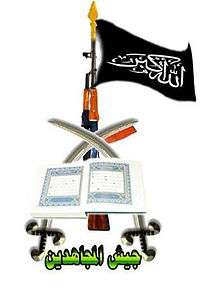Mujahideen Army (Iraq)
The Jaish al-Mujahideen (or Mujahideen Army) is a Sunni militant group in Iraq. The group first emerged in late 2004.[2] The Mujahideen Army is one of the founding members of the Jihad and Reform Front as well as a member of the Political Council for the Iraqi Resistance (PCIR).
| Mujahideen Army Jaysh al-Mujahideen | |
|---|---|
جيش المجاهدين Participant in the Iraq War | |
 | |
| Active | Late 2004 – 2011 2014–2017 |
| Ideology | Sunni Islamism Iraqi nationalism |
| Part of | Jihad and Reform Front Political Council for the Iraqi Resistance |
| Designated as a terrorist organisation by | |
Ideology
Religious in the nature, the Mujahideen Army takes on a more nationalist tone in its rhetoric. The militant group is believed to have an ideology similar to that of fellow Iraqi insurgent group, the Islamic Army in Iraq (IAI).[3]
In May 2006 the Mujahideen Army released a statement condemning Iraq's ethnic and sectarian infighting and urged Iraqis to work "with a sense of national and religious responsibility for the sake of future generations."[3]
In late January 2006, the Mujahideen Army issued a communiqué calling for attacks against Denmark and Norway, in response to the publication of cartoons depicting the Islamic prophet Muhammad in several Danish newspapers.[4]
They also threatened attacks following controversial comments made by Pope Benedict XVI in September 2006.[5] They announced their intention to "destroy their cross in the heart of Rome… and to hit the Vatican."[6]
The Mujahideen Army have also taken the unique step of appealing directly to the American public via several English-language videos purportedly produced and distributed by the group.[7]
Attacks
The Mujahideen Army has taken credit for numerous attacks against American forces in Iraq. The majority of these claims are issued in communiqués or videos posted on mujahideen websites.
Some notable attacks in which the Mujahideen Army has claimed responsibility:
Leadership
Little is publicly known about the Mujahideen Army's leadership and command structure.
In October 2005, the U.S. military announced that it had captured Ahmad Ni'mah Khudayyir Abbas (a.k.a. Abu Shihab), a group "lieutenant and propaganda chief" in the Abu Ghraib district west of Baghdad.[10]
In a January 2006 statement urging the Mujahideen Army to join the then-fledgling Mujahideen Shura Council, al-Qaida in Iraq identified the emir of the Mujahideen Army as "The Leaping Lion."[11]
The intelligence analyst Malcolm Nance claims that Mujahidin Army of Iraq was a liaison between former Baath militias like the fedayeen and the Islamists. However, most Mujahidin Army commanders appear to be former soldiers who were anti-Baathist politically and became Islamist mujahidin after they left army service and the United States invaded.[12] Mujahidin Army spokespeople like Abdul-Rahman Qaisi and Abdullah Umari have been critical of the Baath and want to turn Iraq into an Islamic emirate free of control from occupation
References
- https://www.arabnews.com/node/1239456/middle-east
- Group Profile: Mujahideen Army MIPT Terrorism Knowledge Base
- State of the Sunni Insurgency in Iraq: August 2007 Archived 2007-12-11 at the Wayback Machine NEFA Foundation, August 15, 2007
- Communiqué from the Mujahideen Army of Iraq Archived 2008-05-11 at the Wayback Machine GlobalTerrorAlert.com, January 30, 2006
- Mujahideen's Army threatens Pope with suicide attack The Jerusalem Post, September 16, 2006
- "Vatikan verschärft Sicherheitsvorkehrungen", Der Spiegel, 16 September 2006 (in German)
- "The Mujahideen Army" Releases Video in English Archived 2006-06-25 at the Wayback Machine SITE Institute, March 22, 2005
- Mujahideen Army in Iraq Issues Video of Downing a Black Hawk in al-Niba'i SITE Institute, February 26, 2007
- The Mujahideen Army Issues a Video Depicting the Downing of an Apache Helicopter in al-Taramiya Archived 2006-06-25 at the Wayback Machine SITE Institute, January 16, 2006
- The Jaysh al-Mujahideen terrorist lieutenant and propaganda chief captured GlobalSecurity.org
- Joining al-Qaeda, Declining al-Qaeda ThreatsWatch.org, January 31, 2006
- Malcolm Nance, Terrorists of Iraq, 2014.
External links
- "Al Qaeda in Iraq: Self-Fulfilling Prophecy", article by Peter & Paul Cruickshank, Mother Jones, October 31, 2007